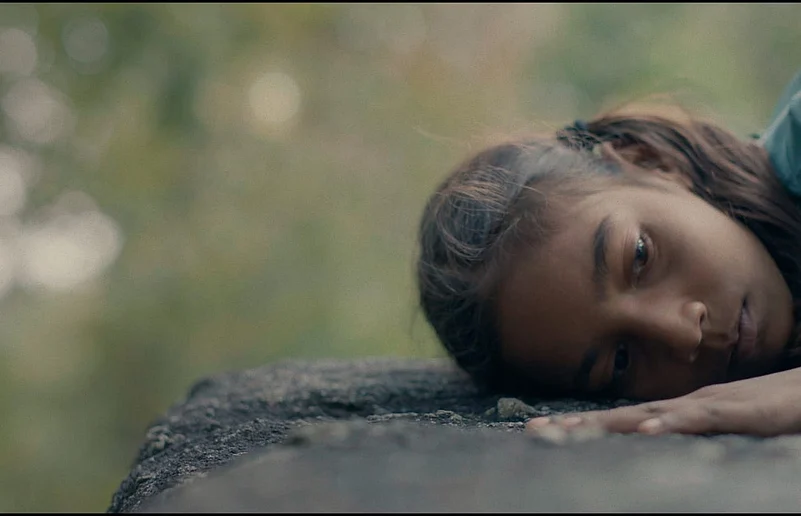
We use cookies to make our site work well
for you and so we can continually improve it.
The cookies that are necessary to
keep the site functioning are always on
Terms and conditions and
Privacy Policy



By Apeksha Priyadarshini
Humans in the Loop is a coming-of-age story: of an adult, a child and artificial intelligence.

A Still from Humans in the Loop Photo: Aranya Sahay
Nehma (Sonal Madhushankar) is in the realm between memory and dream. She sees a younger version of herself, gently stroking the rock surfaces in a cave. Early paintings by her ancestors are etched on these rocks. “Is there life in these rocks, too?” her friend, Roshan (Anurag Lugun) inquires. “Yes,” says Nehma. As they run through a freshly harvested field, he asks, “Do the clouds have life in them, too?” “Yes,” comes the reply. “What about this harvested paddy?” he persists. “Yes, that too,” Nehma patiently answers. “My father says that everything around us has life in it,” she explains. “If you put your ear to a rock and listen carefully, you can hear its heartbeat, too.”
Nehma’s innocent, yet profound insights in this scene encapsulate the essence of Humans in the Loop. Directed by Aranya Sahay, the film premiered at the recently concluded MAMI film festival at Mumbai in October. It is another spectacular addition to the steadily growing cluster of indie films that are exploring the hitherto undiscovered landscape of Jharkhand. Humans in the

A Still from Humans in the Loop Photo: Aranya Sahay
Sahay touches upon the complex social fabric of Adivasi traditions in Jharkhand by showing rituals like Dhuku, but does not pass any moral judgement that usually arrives with an oriental perspective. Instead, he maintains his focus on weaving together a narrative from a remarkably interesting comparison between a child and AI. The chapters of this story are thus, also divided along the same thread of imagination. Enriched by an evocative auralscape, the film lulls you deep into the forests where the Adivasi livelihoods are embedded. Only then is the web of hierarchies uncovered within a community that is perceived as a monolith by the urban class.
It’s intriguing enough to see a “millennial parental apology” film surface from the Indian indie wave, let alone it being pivoted on the tale of an Oraon woman and her young daughter. But Humans in the Loop brilliantly goes a step beyond the conventions of this emergent trope—through the interrogation of human tendencies in artificial intelligence, it offers redemption to both people and technology.

A Still from Humans in the Loop Photo: Aranya Sahay
The root of this redemption lies in a simple idea—what we believe, we become. Thus, the scene described above, about young Nehma’s beliefs, becomes a motif that connects the story across the chapters. When Nehma is questioned by Dhaanu about why she is forcing Adivasi knowledge on her—so many years after abandoning her—Nehma’s faith in herself is shaken. When her AI Centre head scolds her for mis-labelling an insect and applying her own insight onto a preordained task, Nehma’s convictions are further unsettled. The motif of young Nehma recurs at this juncture, to say that the heartbeat in the rocks seems lost.
Humans in the Loop is not a dystopic tale of doom. While emphasizing the importance of human-nature connection in the Anthropocene, it doesn’t induce despair. Instead, it tries to highlight how it is never too late to rebuild hope. In letting go, there are new beginnings to be found. As she loosens the reins on her daughter Dhaanu’s autonomy, Nehma allows her into her own world of vulnerabilities. When she lets go of her own biases, she finds a way to rework the prejudices of AI, too. In a heartrending acknowledgement of Dhaanu’s anger, Nehma says, “I’ve endured so much, that I failed to see that I could be wrong, too.”
The most beautiful aspect of Humans in the Loop is that it is at once both personal and universal—the restoration of a mother-child relationship becomes a metaphor for the need to reconnect with nature for survival. In the process, Sahay is careful that the Adivasi way of life is visibilized, but not romanticised. His role as the filmmaker remains much like the saahi, the porcupine that Nehma befriended as a child. He quietly guides the story through the socio-cultural landscape, just like the saahi drops its quills to guide Dhaanu when she is lost in the forest—hoping that with the no-frills performances of its protagonists, the story will take a life of its own. And so, it does.
Academy-Award nominated film director Mira Nair is best known for her groundbreaking films that cross borders of all kinds: Salaam Bombay! (Caméra D’or, Cannes 1988), the pioneering Asian-African romance Mississippi Masala (1991),
Read More...Head of Jury
David Michôd’s debut feature, Animal Kingdom (2010), won the Sundance Film Festival Grand Jury Prize, earned Oscar and Golden Globe nominations for supporting actress (Jacki Weaver) and was named Best First Film of 2010 by the New York Film Critics Circle. Michôd’s second feature,
Read More...The Criterion Collection calls New York-based Isabel Sandoval ‘one of the most exciting and multitalented filmmakers on the indie scene with a bold approach to cinematic style.’ She has directed three features, including Señorita (2011), which premiered at Locarno,
Read More...Edouard Waintrop has been an Artistic Director of several renowned international film festivals which include the Quinzaine des Réalisateurs in Cannes, a post he held for seven years and Fribourg International Film Festival in Switzerland for four years.
Read More...Kazakh film critic and researcher Dr Gulnara Abikeyeva was an artistic director of the Eurasia International Film Festival in Almaty from 2005 to 2013. She launched the film magazine Asia-kino, served as editor-in-chief of Territoriya Kino, and produced TV programmes about Kazakh cinema.
Read More...Head of Jury
Latika Padgaonkar is a columnist, editor, translator, former Joint Director of Osian’s Cinefan Film Festival, and former Executive Editor of Cinemaya, the Asian film quarterly. She was a foreign correspondent for The Telegraph in Paris in the 1980s;
Read More...Nashen Moodley is in his twelfth year as Festival Director of Sydney Film Festival. During his tenure, the festival has grown vastly. Moodley’s career in film programming has encompassed many leadership roles,
Read More...Aditya Shrikrishna is a freelance film critic and journalist from Chennai. He has been a published writer since 2013, and his work has appeared in The Hindu, Frontline, The Signal, The New Indian Express, Vogue, Fifty Two, Mint Lounge, Film Companion,
Read More...Senior critic, columnist and author Bharathi S. Pradhan is the former editor of Star & Style, Showtime, Lehren, Film Street Journal, Movie and Savvy (Consulting Editor). She continues to be a Sunday columnist with The Telegraph
Read More...Stutee Ghosh is an award-winning radio jockey, having won the prestigious India Radio Forum Best RJ Award. She started off while she was still doing her post-graduation in English Literature at Delhi University
Read More...Epic and intimate, 'Against The Tide' is transportive cinema, on the ground and under the sea. It’s a remarkable achievement, the director is in complete control over every aspect of the medium, plunging us into the elements while never losing sight of its deeply human core. Extraordinary cinematography, great humanity, humour and a wonderful way of seeing.
A deeply empathetic portrait of migrant lives, 'Bahadur' has a beautiful narrative rhythm and clarity of character, with great performances showing the strength of a director able to get a range of emotions from compelling non-actors.
A clear and audacious directorial signature, 'Agra' is unflinching and confident in its exploration of aspirational India.
For uniquely extending this spirit through exemplary innovation of cinematic form, the Rashid Irani Young Critics Choice is awarded to 'Kayo Kayo Colour? (Which Colour?)’.
Like birdsong at daybreak, hope rises from even the darkest nook of this city. Telling us it will get better. That there is joy to be found in what to the naked eye looks like scrap. From the first shot itself, this film evokes a sense of flight, of ascension. Each well-crafted frame and the easy natural performances feed this narrative with beautiful aesthetics, never losing its grip on what the filmmaker is trying to say. Joyous, confident, beautiful, satisfying. This gem of a film is all this and more. In five minutes this young filmmaker has given us hope. With such an easy display of heft and skill. So, of course, The Dimensions Mumbai Gold Award goes to ‘Nightingales In The Cocoon’ by Praveen Giri.
Dimensions Mumbai Silver Award goes to ‘Halfway’ by Kumar Chheda, for its simplicity, the use of the metaphor of meeting halfway in relationships, the writing that brought out nuances of partnerships, the technical execution of the film, the natural performances with the backdrop of a quintessential part of Bombay - the sea and Juhu beach - reminding us that it's a city that allows everyone to exist, without any judgement or differentiation.
The Best Film goes to ‘Summer of Soul’ directed by Sanjib Gogoi for being a moody portrait of sensitivity through strife and for its poetry without frills. A story that reinstates the fact that a bird put in a cage still doesn’t forget flight.
The Best Actor goes to James Elia as Shankar Pillai in Vakuppu for gliding through his performance as an authority figure, a wounded father, and a man weathered by time - all at the same time and all the time.
After much deliberation, considering the varied and engaging subjects of the shortlisted books, the jury has decided to award the meticulously researched book on cinema - ‘The Mahatma on Celluloid, a Cinematic Biography’ by *Prakash Magdum*. This book has significant and enduring value, not only to the student of cinema but also to the historian, the Gandhian and anyone studying media and communication worldwide.
Having a vibrant, perceptive and talented set of mentees made this year's lab sessions fun and stimulating. All these young critics handled a range of writing and participatory exercises with intelligence and sensitivity. Of course, this also made the task of choosing the best critic a difficult one. Here are the three runners-up for this year: Varun Bhakay, Aadhya Kancharla and Vanij Choksi. However, there was one writer who showed a special ability to combine personal, accessible writing with formal analysis and to also weave in a contextual understanding of film history. The best young critic is Diya Mathur.
In recognition of her lifelong commitment as an ambassador of Asian and Indian cinema internationally, and establishment of institutions that enable Asian talent through her work as a film critic, festival director, community builder and creator of organisations like NETPAC.
In recognition of her contribution of outstanding artistic significance to the field of film and cinema, for archiving the legacies of stalwarts of Indian cinema, and making Indian films accessible globally through her impeccable English subtitling of over 800 Indian films and counting.
In recognition of her lifelong commitment to showcasing Indian independent and art-house cinema at film festivals worldwide and creating visibility for Indian filmmakers and talent internationally through her work as a festival programmer and casting director.
Submissions Closed for 2023
Bhumi Pednekar
Ambassador, Dimensions Mumbai
Dimensions Mumbai is a competitive short film section that invites young filmmakers between the ages of 18 and 25 from all over India to submit films on the theme of Mumbai city. The films must be no longer than 5 minutes in length. Shortlisted films from all the entries will be shown on the big screen to an enthusiastic Jio MAMI audience. Dimensions Mumbai was first introduced to Jio MAMI Mumbai Film Festival in 2009 by Ms. Jaya Bachchan, and since then it's been one of the most sought-after sections at the festival. Many filmmakers who've won at Dimensions Mumbai have gone on to direct feature films and web-series.
Please read the Rules and Regulations by clicking on the View & Download Button below.
Jio MAMI Mumbai Film Festival will be held from October 27 to November 5, 2023 in Mumbai.
This year, Jio MAMI announces its new vision to host the world’s biggest and most prestigious South Asian Film Festival and Year Round Programme, focused on building an ecosystem for new cinematic voices, facilitating exchange of ideas, collaborations and business opportunities while bringing the best of world cinema to Mumbai. Jio MAMI will have two sections for South Asian and South Asian Diaspora filmmakers -
In addition to the above, Jio MAMI will showcase feature length films in the World Cinema section from around the world.
Submissions for the South Asia and World Cinema sections of the festival are closed.
Please read the Rules and Regulations by clicking on the View & Download Button below.
Copyright © 2025 by Mumbai Academy of Moving Image. All Rights Reserved.
